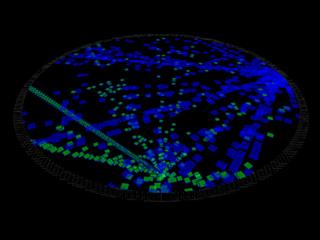Jonathan Cousins
Information Recast: A Flexible Map
A 2D and 3D info viz of global immigration data in a flexible environment where users can re-arrange the elements.
http://www.jonathancousins.com/information_recast/map

The amount and kind of data we collect has exploded since the advent of computers. Increasingly, designers, scientists, artists and other professionals look for new ways to visualize that data in an effort to test hypotheses or introduce new ideas. This project is an exploration of new visualization techniques. A special focus has been placed on creating an interface that allows a user to change the physical arrangement and other aesthetic features of a visualization. The question and ultimate goal is determine if this increases the likelihood of discovery and new conclusions.
My contextual sources that pre-date the 1950s are broad. They include everything from piano rolls to pre-Columbian world maps.
The following sources of context are all relatively recent:
Bureau d\'etudes, The World Government, 2003
Dominique Brodbeck and Luc Girardin, Macrofocus, City\'O\'Scope, 2000
Brian McGrath and Mark Watkins, Manhattan Timeformations, 2000
Those interested in data visualization, information architecture, and user experience and interface design.
For the thesis presentation and hopefully for the show, I would like to use one of the ITP G5 computers, but I could use my laptop. This machine would drive a projector that will project onto a 2\' X 3\' sheet of teleprompter glass. The configuration is simple. I have included an illustrator sketch of the project (see second image file attached above). In brief, a user would stand in front of a high table with nothing but a black cloth on it and a mouse (no keyboard or LCD monitor). The hanging glass is only a few feet away and the projector throws the image onto it at a 45 degree angle. A black curtain a few feet behind the glass helps create the illusion that the interface is suspended in thin air. The user can interact with the projection on the screen as they would with any traditional monitor. I have a diagram as one of the attached image files above and there is a web version available (linked to above). Please contact me should you have any questions.
Three basic stages:
1.) Selecting a data set and making determinations about how to use it. For example, in this stage I looked closely at using total global immigration versus global asylum seekers.
2.) Building an underlying framework. I built a MySQL database to hold the data (approximately 20,000 cells) and wrote a several php scripts to generate a variety of results. This stage involved solving some of the basic code challenges for the Processing software, for example, how to translate latitude and longitude points to on screen vectors.
3.) Developing and implementing the coding strategy for the software and interface in Processing. For example, how to write classes to handle particle systems, vectors for 3D viewing, hash tables and so on.
My contextual sources that pre-date the 1950s are broad. They include everything from piano rolls to pre-Columbian world maps.
The following sources of context are all relatively recent:
Bureau d\'etudes, The World Government, 2003
Dominique Brodbeck and Luc Girardin, Macrofocus, City\'O\'Scope, 2000
Brian McGrath and Mark Watkins, Manhattan Timeformations, 2000
Those interested in data visualization, information architecture, and user experience and interface design.
For the thesis presentation and hopefully for the show, I would like to use one of the ITP G5 computers, but I could use my laptop. This machine would drive a projector that will project onto a 2\' X 3\' sheet of teleprompter glass. The configuration is simple. I have included an illustrator sketch of the project (see second image file attached above). In brief, a user would stand in front of a high table with nothing but a black cloth on it and a mouse (no keyboard or LCD monitor). The hanging glass is only a few feet away and the projector throws the image onto it at a 45 degree angle. A black curtain a few feet behind the glass helps create the illusion that the interface is suspended in thin air. The user can interact with the projection on the screen as they would with any traditional monitor. I have a diagram as one of the attached image files above and there is a web version available (linked to above). Please contact me should you have any questions.
Three basic stages:
1.) Selecting a data set and making determinations about how to use it. For example, in this stage I looked closely at using total global immigration versus global asylum seekers.
2.) Building an underlying framework. I built a MySQL database to hold the data (approximately 20,000 cells) and wrote a several php scripts to generate a variety of results. This stage involved solving some of the basic code challenges for the Processing software, for example, how to translate latitude and longitude points to on screen vectors.
3.) Developing and implementing the coding strategy for the software and interface in Processing. For example, how to write classes to handle particle systems, vectors for 3D viewing, hash tables and so on.
